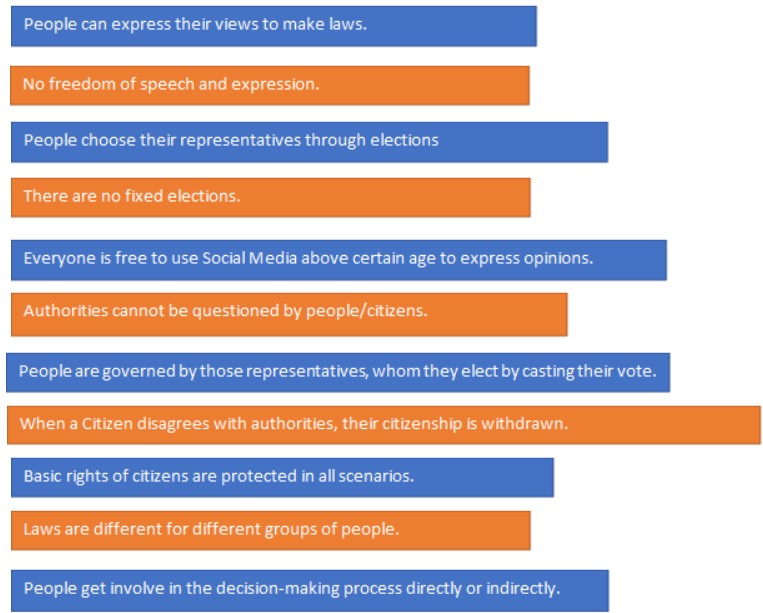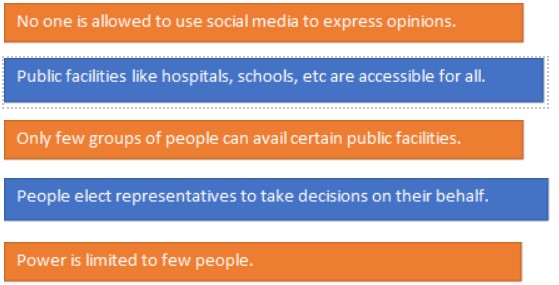

KLE September Activity – Recognising Democracy
OBJECTIVES
- Students will be able to explain the meaning of Democracy.
- Students will be able to recognize presence of democracy in situations.
OUTCOMES
- Students will be able to describe their understanding of democracy in their own words.
SKILLS AND VALUES
Skills – Collaboration, Communication
Values – Democratic Spirit
SESSIONS’ OVERVIEW
| S. No. | Session Details | Estimated Time Required |
| 1 | Step 1: Introduction
Step 2: Role Play |
45 Minutes |
| 2 | Step 3: Game: Recognizing Democracy
Step 4: Debrief of Activity |
45 Minutes |
MATERIAL REQUIRED
Notebooks, pens, chart paper/plain A4 size paper/blank papers
STEPS OF THE ACTIVITY
Session 1: For a 45 min session Step 1-2
STEP 1 – INTRODUCTION
Time: (10 - 15 Min)
- Teacher will tell the students that today with help of Role play we will see two scenarios.
- Teacher will then divide the class into two groups A and B. Each group will select students to play the characters in the play as per the group script given in Annexure 1 and give them 10 minutes to prepare.
Note: Teacher can also identify the characters and prepare them before the class to present the roleplay
Step 2 – Role Play
Estimated Time: 25-30 mins.
1. Teacher will invite Group A, to present their roleplay as per the script given.
2. Teacher will then ask group B, to present their roleplay to the students as per the script.
3. The teacher will then ask other students the following questions.
- What are your observations from the role play?
- In which situation will people be happier?
- How is situation 1 different from situation 2?
- In the last activity we made rules for our country, which option of making the rules would you prefer?
- Which features of people participation did you observe in situation 2?
- What does situation 2 represent?
4. Conclude the session with discussion on what democracy means and the role of people participating in it.
Homework (Optional)
Ask students to read more about Democracy. They can refer to textbooks or other reference materials available in Library. They can also ask their parents about it.
Session 2: Step 3 – 5
Step 3 – Recap
Estimated Time (10 Mins)
Begin the class by narrating the students the following scenario:
Raja, and his friends meet on a Saturday morning trying to decide what to do that day. Raja and few others want to play cricket, but few others want to play hide and seek. Some suggest playing carrom and remaining wants to play Chinese Whispers/Antakshri.
There are two ways the group can decide what to do -
Option 1 – Raja is the most healthy and strong student so everyone should do as per his will.
Option 2 – All options are discussed, and group decides to an option that everyone agrees to play.
Ask the student - Which option represents democracy while selecting what to play on the ground? Why?
Teacher will then tell the students that last time with help of roleplay we understood about democracy. Today we will play a game of sorting to identify statements that represents democracy.
Step 4 – Game – Identifying Democracy
Estimated Time (25 Mins)
- Teacher will tell the students that we will play a sorting game in pairs & divide them as per their seating arrangement. (If there are three students sitting on a bench, then its teacher’s choice to play the game in pairs or trios)
- In this game, teacher will read out one statement, each pair must quickly discuss if the statement is representing democracy or not. Tell them they will have about 1 min to discuss in themselves.
- Teacher will then clap as a signal. As the teacher claps, if the pair thinks the statement represents democracy, then they will stay seated otherwise they will stand. (Teacher can decide the action has to be stand/raising hand as per the class size. For large size class, raising hand will be feasible option)
- In this manner teacher reads out 8-10 statements from Annexure 2, ensure there is enough balance of both type of statements.
- For democracy present statement, teacher can ask 1-2 students why they chose this the answer or how it represents democracy?
- For every correct answer by the pair, they will get 1 point. Pairs can maintain their own score sheet.
- After scoring, teacher can ask in group who got points in range of 8-10, range of 5-8 and below 5 and appreciate the class.
Step 5 – Debrief of Activity
Estimated time: 5-7 mins.
Ask students the following questions to debrief the activity:
- What have you learnt from the activity?
- What according to you is democracy? Give examples of actions possible in democracy.
Reflection Sheets, Activity Report & Feedback Form
Teachers kindly fill in the feedback form, remind office bearers to fill activity report and remind students also to fill up the reflection sheets.
REFLECTION SHEET (TO BE FILLED BY STUDENTS)
REFERENCE SECTION / ANNEXURE
Annexure 1 – Role Play Script
| Situation 1 – Group A
Characters Narrator Management Person Principal Teacher 3-4 teachers (no dialogue) 3-4 students (no dialogue) (Narrator – In a certain School, A management person and School Principal are talking with each other) Management Person: Principal Sharma, how are you? Management has decided these rules for school. Inform everyone about them. Principal (reading the rules & shocked expression): These rules are shocking. None of the parents or teachers including me were consulted for these rules. Management: Just do as I say, go and share these rules with everyone. Everyone has to follow them. (Narrator - Principal goes and reads out the rules to teachers) Principal: Management has decided a few rules without any consultation with the principal, teachers, parents, etc. I will release a circular to parents about these rules. Also, display them on notice board. To inform the students, teachers read these rules in your class. (3-4 teachers nodding their head as they listen to Principal.) Narrator – Teacher reading the rules to students. Teacher: School Management has decided on a few rules which are applicable going forward. They are: 1) Children will sit for entire year in the same seat as assigned by teacher. 2) Common hair cut for all boys and common hair cut for all girls. 3) Common punishment for any kind of offence big or small. 4) Even if one person is talking in the class, the teacher will ask the whole class to do extra work. 5) Girls will have sports period and Boy will have Music period for Grade 7 students. Students murmur among themselves discussing the rules. |
| Situation 2 – Group B
Teacher: As we start this new academic year, let us all come together and decide 3-4 rules that all of you will follow in class. Rita raises her hand. Rita – We will not run here and there in class. Some children disagree and make noises, Shyam raises his hand. Teacher – Yes Shyam. Shyam – We can say that – We will not run here and there in class while class is going on. Everyone agrees and teacher writes the rule on board. Rohan – We will not litter in the classroom. Everyone agrees and teacher writes on the board. Seema – We will not talk when the teacher is teaching. Teacher – Instead we can frame it as – We will listen attentively when teacher is teaching. Everyone agrees and teacher writes on the board. In this manner, 4-5 rules for classroom are decided. Teacher – what will happen if any of you are found breaking the rules made. Tina – We can decide a consequence if any one of us is found not following the rule. The teacher agrees and asks them to select a few students who will compile these consequences for class. The class chooses Seema, Rohan, Rita, and Shyam to create a list of some consequences on behalf of the class. |
Annexure 2 – Clue Statement for Game
Teacher can select any 8-10 statements randomly. Ensure balance between orange and blue statements. Blue statements represent Democracy.








